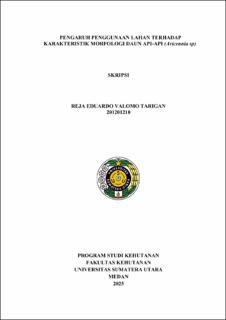| dc.description.abstract | Mangroves are unique and important coastal ecosystems because of their
role in protecting the coast from abrasion, dampening waves, and maintaining
microclimate stability. However, mangrove areas such as in Percut Sei Tuan and
Medan Belawan are experiencing land use change into ponds and industrial areas,
which has an impact on habitat destruction and decreased biodiversity. One of the
dominant mangrove species is api-api (Avicennia sp). This study aims to determine
the effect of land use on the morphological characteristics of api-api (Avicennia
sp) leaves in two different locations. The three Avicennia species studied were A.
marina, A. officinalis and A. alba. The samples were measured on 8 variables such
as shape, length, width, bone and leaf color. Then the measurement results are
continued with PCA, Biplot and Cluster tests. At the location studied,
environmental data were taken such as salinity, temperature, water pH, water
density (EC), water solution density (TDS), wind speed, light intensity, air humidity.
Based on research on the morphological characteristics of api-api leaves
(Avicennia sp) in Percut Sei Tuan and Belawan, it can be concluded that
environmental conditions greatly affect the morphological characteristics of
mangrove leaves. Species growing in Percut Sei Tuan showed relatively larger leaf
sizes, more optimized shapes, and more developed morphological structures
compared to species growing in Belawan, indicating adaptation to environmental
stresses such as pollution and anthropogenic disturbances. This was evidenced
through morphometric analysis as well as multivariate analysis such as PCA,
biplots, and clusters that showed cluster separation by location and species. One
species, A. marina, showed high adaptability at both sites, indicating resilience to
variations in environmental conditions. | en_US |


